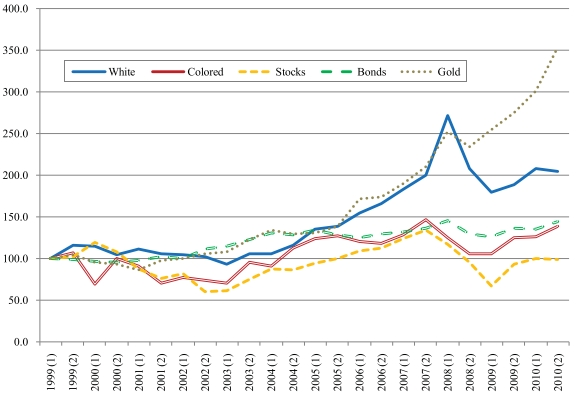Do gems offer good returns? How do the returns of these tangible assets compare with those of other asset classes? In the April 2011 version of their paper entitled “Hard Assets: The Returns on Rare Diamonds and Gems”, Luc Renneboog and Christophe Spaenjers examine recent returns on precious gems in U.S. dollars. They concentrate on the upper end of gem quality for three categories: white diamonds, colored diamonds and other gems (emeralds, rubies and sapphires). They consider gem attributes such as weight, color, clarity, cut, location of sale, auction house, brand and certification as allowed by subsample sizes. Using worldwide auction data spanning 1999 (the first year of representative coverage in the source database) through 2010 (3,952 total sales), along with the contemporaneous values of the U.S. Consumer Price Index and returns for other worldwide asset markets, they find that:
- Over the entire sample period:
- Transaction frequencies are 2,033 for white diamonds, 1,086 for colored diamonds and 832 for other gems.
- White (colored) diamonds generate an annualized gross real return of 6.4% (2.9%), compared to -0.1% for stocks, 3.3% for government bonds and 11.6% for gold. Negative gross real returns occur during subperiods related to the dot-com bust and the recent financial crisis, but subsequent rebounds more than compensate (see the chart below).
- Based on gross Sharpe ratio, white diamonds substantially outperform stocks and match government bonds.
- Gem returns relate positively to stock market returns, suggesting a stock market wealth effect.
- Since 2003, annualized gross real returns are 10%, 5.5% and 6.8% for white diamonds, colored diamonds and other gems, respectively. Corresponding annualized gross nominal returns are 12.6%, 8.0% and 9.5%.
- Returns may be slightly greater on average, but also more volatile, for higher-quality gems.
The following chart, taken from the paper, compares cumulative real price indexes for white diamonds, colored diamonds, stocks, government bonds and gold measured at six-month intervals over the 1999-2010 sample period. For all asset classes, indexes are normalized to 100 for the first half of 1999. White diamonds outperform stocks and government bonds, but not gold, over the sample period. Colored diamonds beat stocks and perform about as well as government bonds. Equity market shocks tend to depress the gem market.

In summary, evidence from a limited recent sample period supports a belief that gems tend to appreciate at rates roughly comparable to those of other asset classes.
- As noted in the paper, the sample period is short, especially in terms of market shocks. Supply metering by the principal source of diamonds (de Beers) affects realistic return on investment calculations over long periods.
- Reported returns are gross, not net, and transaction costs for gem auctions (principally, the auction house commissions) are very large (on the order of 10% of price each way) compared to trading frictions for stocks, bonds and gold. While a long holding period would mitigate, these transaction costs would make net returns to investors materially lower.